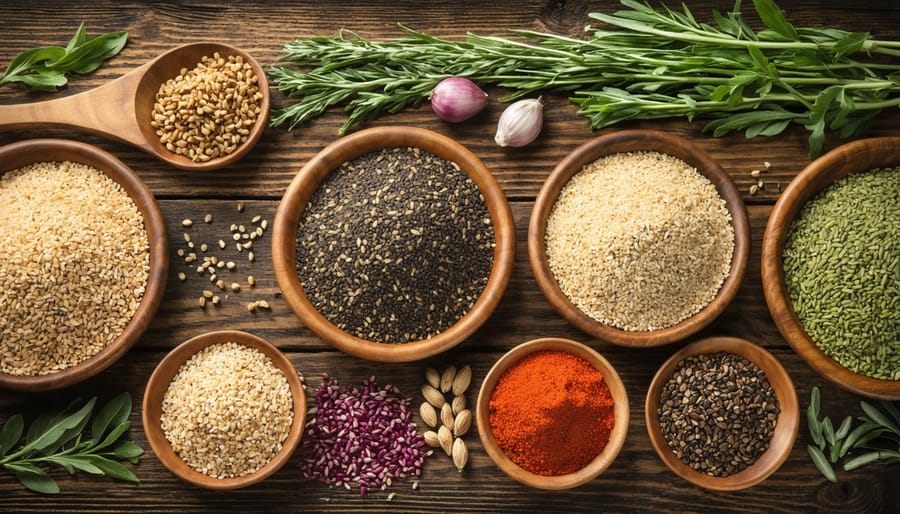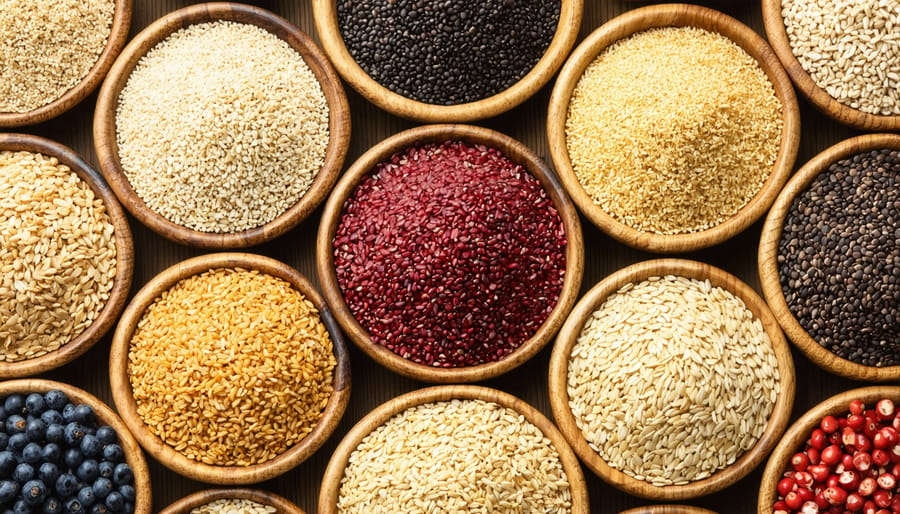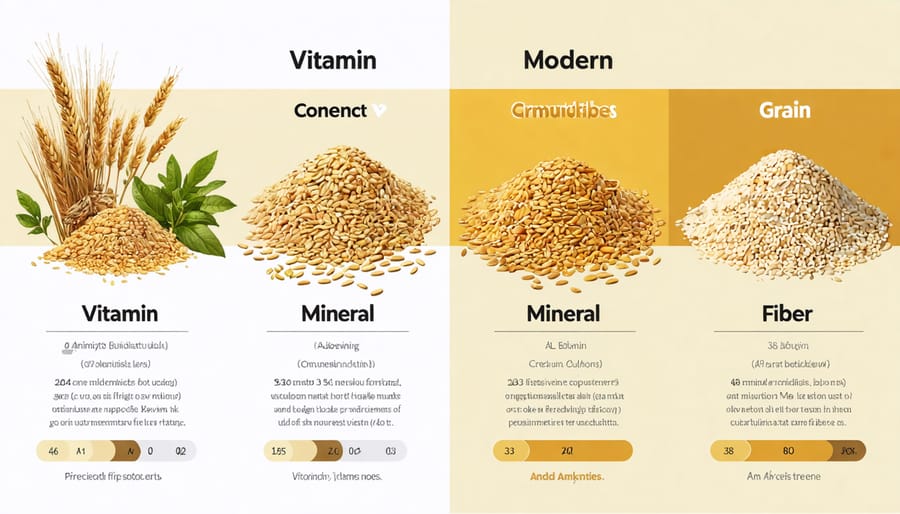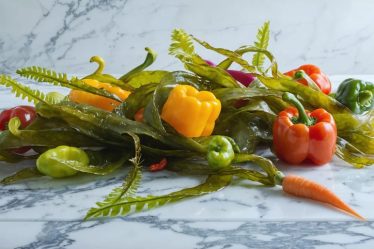
Ancient grains like quinoa, amaranth, and teff aren’t just trendy alternatives to modern wheat – they’re nutritional powerhouses that have sustained civilizations for thousands of years. While our ancestors might not have known the science behind these grains, research now confirms what they discovered through generations of wisdom: ancient grains pack a serious health punch.
As someone who switched from regular white rice to ancient grains three years ago, I’ve experienced firsthand how these nutritional gems can transform both your plate and your wellbeing. They’re rich in fiber, protein, and essential minerals that many modern, processed grains lack. Plus, many ancient grains are naturally gluten-free, making them perfect for those with sensitivities or anyone looking to diversify their diet.
But here’s what really matters: these grains aren’t just healthy – they’re incredibly versatile and delicious. Whether you’re whipping up a quick breakfast bowl or preparing a hearty dinner, ancient grains can elevate both the nutritional value and flavor of your meals. Let’s explore why these time-tested ingredients deserve a place in your modern kitchen.
What Makes Ancient Grains Special?
The Ancient vs. Modern Grain Difference
Remember when your grandmother talked about how bread “just tasted different” back in her day? Well, she wasn’t imagining things! The main difference between ancient and modern grains lies in how they’ve evolved over time. Modern wheat has been extensively bred to increase yield and resist pests, which has inadvertently changed its nutritional profile. Ancient grains, like quinoa, amaranth, and spelt, remain largely unchanged from their original form.
Think of it this way: modern grains are like carefully curated garden plants, while ancient grains are like wildflowers growing naturally in a meadow. Modern processing methods often strip grains of their nutrient-rich outer layers to create refined products with longer shelf lives. In contrast, ancient grains are typically consumed in their whole form, preserving their natural nutritional benefits.
What’s particularly interesting is that ancient grains haven’t undergone the intensive hybridization that modern wheat has, potentially making them easier to digest for some people.
Common Types of Ancient Grains
Let’s dive into some of the most popular ancient grains that have made their way into modern kitchens! Quinoa, often called the “mother grain” by the Incas, has become a household name thanks to its complete protein profile and fluffy texture. It’s perfect for those busy weeknight grain bowls I love to make.
Amaranth, another nutritional powerhouse, is actually a tiny seed that cooks up into a creamy, porridge-like dish. I’ve found it makes an amazing breakfast option when topped with fresh fruit and a drizzle of honey. Spelt, an ancient cousin of modern wheat, has a lovely nutty flavor that works beautifully in homemade bread and pasta.
Other fascinating options include kamut, with its buttery taste and chewy texture, and teff, the tiny grain that’s been a staple in Ethiopian cuisine for thousands of years. Even if you’re new to ancient grains, starting with just one of these in your next meal can open up a world of delicious possibilities!

Health Benefits That Actually Matter
Nutrient Density
Let me share something that amazed me when I first started exploring ancient grains – their incredible nutritional profiles are like nature’s multivitamins! These nutritional powerhouses pack more vitamins, minerals, and fiber than many of their modern counterparts.
Take quinoa, for instance. In just one cup, you’ll find all nine essential amino acids (something rare in plant foods!), plus impressive amounts of magnesium, iron, and zinc. Amaranth brings its A-game with lysine (an amino acid often missing in grains) and calcium levels that put many other grains to shame.
The fiber content in ancient grains is particularly noteworthy. Farro contains about 8 grams of fiber per cup, while teff delivers an impressive 7 grams. This fiber isn’t just good for digestion – it helps maintain steady blood sugar levels and keeps you feeling satisfied longer.
What I love most about ancient grains is their mineral content. Kamut offers 40% of your daily selenium needs, while spelt is rich in manganese and phosphorus. Even better, many ancient grains haven’t been stripped of their natural nutrients through modern processing methods, meaning you’re getting the full nutritional benefits nature intended.
Remember, each ancient grain has its own unique nutritional profile, making them perfect for creating varied, nutrient-rich meals that nourish your body in different ways.

Digestive Benefits
When it comes to digestive health, ancient grains are true champions of gut-friendly nutrition. Unlike their modern counterparts, these grains retain their original fiber content and natural compounds that work wonders for our digestive system. I’ve personally noticed a significant difference in my digestion since incorporating ancient grains into my mindful eating habits, and many of my readers share similar experiences.
Ancient grains are particularly rich in prebiotic fiber, which acts as food for the beneficial bacteria in our gut. Quinoa, for instance, contains fiber that helps maintain regular bowel movements while reducing bloating. Amaranth and teff are especially gentle on the digestive system, making them excellent choices for those with sensitive stomachs.
What makes these grains particularly special is their fermentable fiber content. As these fibers break down in our gut, they produce short-chain fatty acids that help maintain the health of our intestinal lining. This process not only aids digestion but also supports our immune system, as much of our immune function is linked to gut health.
For those new to ancient grains, start by introducing them gradually into your diet. Try substituting your regular rice with quinoa once or twice a week, or experiment with amaranth porridge for breakfast. Your digestive system will thank you as it adjusts to these nutrient-rich alternatives.
Incorporating Ancient Grains Into Your Modern Kitchen
Simple Cooking Methods
Getting started with ancient grains is easier than you might think! As someone who was once intimidated by these wholesome ingredients, I’ve discovered that most ancient grains follow similar cooking methods to regular rice or quinoa.
The basic ratio for most ancient grains is typically two parts water to one part grain. For chewy, nutty farro, simply combine it with water in a pot, bring to a boil, then reduce heat and simmer for about 30 minutes. Amaranth, which I love for its protein-packed profile, cooks up in just 20 minutes using the same method.
Quick tip: Toasting your grains in a dry pan for a few minutes before cooking can enhance their natural flavors – something I learned from my grandmother! For quinoa, remember to rinse it thoroughly first to remove any bitter coating.
If you’re short on time, try cooking larger batches and freezing portions for later use. I often prep amaranth or millet on Sunday evenings for quick breakfast porridges throughout the week. For extra convenience, many ancient grains can be prepared in a rice cooker or instant pot – just follow the manufacturer’s guidelines for brown rice.
Some grains, like teff and buckwheat, cook much faster (15-20 minutes), making them perfect for busy weeknight meals. Remember to let your grains rest for about 5 minutes after cooking, just like you would with rice.

Easy Recipe Ideas
Ready to transform ancient grains into delicious healthy homemade meals? Let’s explore some simple recipes that make these nutritious ingredients shine!
Start your morning with a warming quinoa breakfast bowl. Simply cook quinoa in your choice of milk (dairy or plant-based), add a drizzle of honey, and top with fresh fruits and nuts. It’s like oatmeal but with an ancient twist!
For lunch, try a farro salad that’s both satisfying and fresh. Cook farro until tender, then toss with cherry tomatoes, cucumber, feta cheese, and a light lemon-olive oil dressing. This keeps well in the fridge, making it perfect for meal prep.
Dinner can be as simple as a one-pot amaranth and black bean bowl. Simmer amaranth with vegetable broth, add black beans, corn, and your favorite Mexican-inspired seasonings. Top with avocado and lime juice for a filling meal that comes together in under 30 minutes.
For a quick side dish, try teff as a polenta alternative. Cook it with water until creamy, add some butter and parmesan, and you’ve got a delicious grain that pairs perfectly with roasted vegetables or grilled protein.
Don’t forget snacks! Make a batch of spelt flour banana muffins for a wholesome treat that’s perfect for busy days. These ancient grain recipes prove that eating well doesn’t have to be complicated or time-consuming.
Making Smart Choices
Let me share a little secret from my own kitchen adventures: smart shopping for ancient grains doesn’t have to be complicated or break the bank! While these nutritious gems might cost a bit more than conventional grains, there are plenty of ways to make them work for your budget.
Start by checking out bulk bins at your local health food store or co-op – they’re usually more cost-effective than packaged options, and you can buy exactly what you need. I’ve found that stores like Whole Foods and Trader Joe’s often have competitive prices on ancient grains, especially their store brands.
When it comes to storage, treat your ancient grains like the treasures they are. Store them in airtight containers in a cool, dry place – I use clear glass jars so I can easily see what I have. Most ancient grains will keep for up to six months in your pantry, or up to a year in the freezer if you want to stock up during sales.
Look for grains that are well-sealed and free from moisture or signs of pest activity. If you’re new to ancient grains, start with smaller quantities to test what you like. Many of these grains expand significantly when cooked, so a little goes a long way – quinoa typically triples in volume!
Pro tip: Some specialty grocery stores offer periodic sales on ancient grains, so consider signing up for their newsletters to catch the best deals.
Ancient grains are more than just a trendy food choice – they’re a delicious gateway to better nutrition and wellness. From the protein-packed quinoa to the fiber-rich amaranth, these time-tested grains offer an impressive array of health benefits that our modern bodies crave. Whether you’re looking to boost your fiber intake, add more nutrients to your diet, or simply try something new in the kitchen, ancient grains deserve a spot in your pantry. Start small by swapping your regular rice with farro in your next Buddha bowl, or experiment with teff in your morning porridge. Remember, every healthy change starts with a single step, and incorporating these nutritious grains into your meals could be the perfect way to enhance your wellbeing while discovering exciting new flavors and textures. Your body – and taste buds – will thank you for making the switch!



